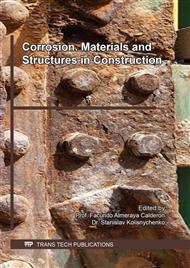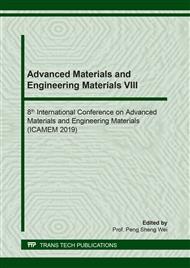[1]
P. Colajanni, L. La Mendola, G. Mancini, A. Recupero, N. Spinella, Shear capacity in concrete beams reinforced by stirrups with two different inclinations, Eng. Struct. 81 (2014) 444-453.
DOI: 10.1016/j.engstruct.2014.10.011
Google Scholar
[2]
P. Colajanni, A. Recupero, G. Ricciardi, N. Spinella, Failure by corrosion in PC bridges: A case history of a viaduct in Italy, Int. J. Struct. Integr. 7-2 (2016) 181-193.
DOI: 10.1108/ijsi-09-2014-0046
Google Scholar
[3]
P. Colajanni, A. Recupero, N. Spinella, Shear strength degradation due to flexural ductility demand in circular RC columns, Bull. Earth. Eng. 13-6 (2015) 1795-1807.
DOI: 10.1007/s10518-014-9691-0
Google Scholar
[4]
S. Coccia, S. Imperatore, Z. Rinaldi, Influence of corrosion on the bond strength of steel rebars in concrete, Mat. Struct. 49-1-2 (2016) 537-551.
DOI: 10.1617/s11527-014-0518-x
Google Scholar
[5]
A. Recupero, N. Spinella, F. Tondolo, Failure analysis of corroded RC beams subjected to shear-flexural actions, Eng. Fail. Anal. 93 (2018) 26-37.
DOI: 10.1016/j.engfailanal.2018.06.025
Google Scholar
[6]
K. Lundgren, M. Tahershamsi, K. Zandi, M. Plos, Tests on anchorage of naturally corroded reinforcement in concrete, Mat. Struct. 48-7 (2015) 2009-2022.
DOI: 10.1617/s11527-014-0290-y
Google Scholar
[7]
G. Mancini, F. Tondolo, Effect of bond degradation due to corrosion - a literature survey, Str. Conc. 15 (2014) 408-418.
DOI: 10.1002/suco.201300009
Google Scholar
[8]
A. P. Fantilli, P. Vallini, Bond-slip relationship for smooth steel reinforcement, Conf. comp. modell. Conc. Str. (EURO-C 2003) 1 (2003) 215-224.
Google Scholar
[9]
K. Lundgren, P. Kettil, K. Z. Hanjari, H. Schulne, A. S. San Roman, Analytical model for the bond-slip behaviour of corroded ribbed reinforcement, Str. Inf. Eng. 8 (2012) 157-169.
DOI: 10.1080/15732470903446993
Google Scholar
[10]
Ceb, CEB-FIP Model Code 90, T. Telford, London, (1993).
Google Scholar
[11]
J. Ožbolt, F. Oršanić, G. Balabanić, Modeling pull-out resistance of corroded reinforcement in concrete: Coupled three-dimensional finite element model, Cem. Conc. Comp. 46 (2014) 41-55.
DOI: 10.1016/j.cemconcomp.2013.10.014
Google Scholar
[12]
L. Hussein, L. Amleh, Analytical modelling of bond stress at steel-concrete interface due to corrosion, Str. Conc. 4 (2016) 541-552.
DOI: 10.1002/suco.201500109
Google Scholar
[13]
M. Blomfos. K. Zandi, K. Lundgren, D. Coronelli, Engineering bond model for corroded reinforcement, Eng. Struct. 156 (2018) 394-410.
DOI: 10.1016/j.engstruct.2017.11.030
Google Scholar
[14]
A. Cesetti, G. Mancini, F. Tondolo, A model for bond in concrete under corrosion conditions, 3rd International Symposium on Connections between Steel and Concrete, Germany, (2017).
Google Scholar
[15]
K. Noghabai, Effect of Tension Softening on the Performance of Concrete Structures, (1998).
Google Scholar
[16]
International Federation for Structural Concrete (fib), fib Model Code for Concrete Structures 2010, first ed., Ernst & Sohn, (2013).
DOI: 10.1002/9783433604090
Google Scholar
[17]
S. P. Tastani, S. J. Pantazopoulou, Direct tension pullout bond test: Experimental results, J. Str. Eng. 136 (2012) 731-743.
DOI: 10.1061/(asce)st.1943-541x.0000159
Google Scholar
[18]
D. Coronelli, Corrosion cracking and bond strength modeling for corroded bars in reinforced concrete, ACI Str. J. 99 (2002) 267-276.
DOI: 10.14359/11910
Google Scholar
[19]
A. Castel, I. Khan, R.François, R.I. Gilbert, Modeling steel concrete bond strength reduction due to corrosion, Aci Str. J. 113 (2016) 973-982.
DOI: 10.14359/51688925
Google Scholar



